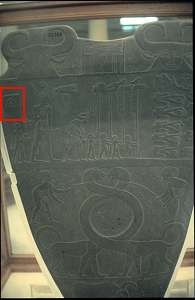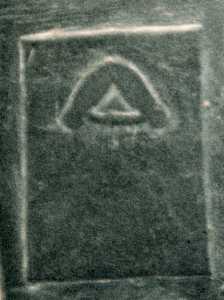Orthodox Egyptology is sure that the three large pyramids at Giza were built by the pharaohs Chufu, Kafre and Menkaure ( 2589 - 2503 BCE[ 1 ]) of the 4th dynasty of Egypt. But they seem to ignore evidence that places the pyramids to a much older date. According to that the pyramids of Giza and the Sphinx still stood when Egypt was born...
 Zecharia Sitchin, famous author and so-called orientalist is sure to have found some evidence that should demonstrate that the pyramids of Giza and the great Sphinx were already known 500 years before Chufu.[2]
Zecharia Sitchin, famous author and so-called orientalist is sure to have found some evidence that should demonstrate that the pyramids of Giza and the great Sphinx were already known 500 years before Chufu.[2]
However, the pictures do not originate from Egypt but from Mesopotamia, some 100 km away from Egypt. Why the people there should have any interest in making pictures from Egyptian pyramids, although they were pyramid builders themselves, remains the secret of Sitchin. Additionally I miss any reference for the age of the pictures Sitchin proposes. The Mesopotamian culture had an art style which was almost unchanged for more than 2000 years, so without definitive dating of each picture these are worthless as evidence for a specific age. Since Sitchin does not name the pictures further it is also impossible to check the dating, so it is a matter of faith to trust Sitchins claims or not.
The faith is shaken very fast when we examine the contents of the pictures and compare it with Sitchins claims. The most convincing picture[3] is shown on the left. Sitchin claims that the two animals are in fact representations of the Great Sphinx at Giza. And that then the pyramid on the right MUST be the great one at Giza, because "Even details like the inclination - 52 degrees - are matching"[ 4 ].
Hm, a goniometer shows: the pyramid-shaped something has an inclination of 45 degrees and not, as Sitchin claims, of 52 degrees. And the Great Pyramid does not have two large palm leaves at its top, if I remember correctly :-)
And what about the Sphinx? Please click on the picture (like all pictures with a frame on these pages it is a link to an enlarged version) and take a look for yourself. The statue of the Sphinx, like all sphinxes in Egypt, has the body of a powerful lion, with paws put put forward, strong hind legs and a lion tail. The two animals in the picture are, however, clearly cows. The position of the fore legs would be completely impossible for a lion, since their "elbows" are, like ours, bent back and not forwards like the "elbows" of cattle.
But what else is the pyramid-shaped thing? Well, nothing more than a simple reed hut, bound together at the top and crowned with two palm leafs. The whole picture shows an agricultural scene with grazing cows, fishermen and a hut. Typical for Mesopotamia.

Another piece of evidence looks better: a pyramid on the so-called Narmer- or unification-palette[5]. It shows the moment of the unification of upper- and lower Egypt by the hands of the mythical pharaoh Menes. Mythical because nobody knows if Menes ever existed in real life or not. One good candidate for Menes would be Hor Aha, whose birth name is "Mnj", which can be read as "Meni". And "Meni" is the name for the first king of Egypt according to the chronicles of Manetho. Unfortunately the main name on this palette is Hor Nar-Mer and not Hor Aha, so the case is not closed yet.
The palette shows the bloody conquest of northern Egypt by the south. But there are no signs in Egyptian history telling the story of a war. The general opinion is, that the unification was a peaceful process lasting several 100 years, and that this palette only shows a myth. But sure is that this thing is about 500 years older than the pyramids. A pyramid depicted on this palette would be a strong piece of evidence for the case of prehistoric pyramids.
Sitchin tells us, that the pyramid can bee seen on the back side. As so often he only has a unsatisfying drawing of it in his book. The pyramid is right behind the head of the pharaoh, in the red square on my photo on the left. After a visit to the Egyptian Museum in Cairo (where I made the photos) I was able to notice for the first, but not the last time, that Sitchin "corrected" the picture for his book. Where one can see bulging lines to the inner side of the inner triangle, he straightened them out, and he also enlarged the inner triangle. But even then the structure does not look like a pyramid, more like a broad letter "A". With soft, bulged outlines. Or should the inner triangle (which Sitchin had made straighter in his drawing) be the pyramid? If so, it would be a very poor representation. And it leaves the question: Why was the unknown artist unable to make straight lines at the "pyramid"? He could do so on other parts of the palette.

From the first moment I saw the picture I had the opinion that this structure must be something else. Something like a boomerang (yes, the Egyptians had them :-) ) or another throwing weapon. Clarification came with a mail exchange with a British Egyptologist. The "pyramid" is no picture at all, it is, like other objects on the palette, part of an inscription. In these early times the separation between text and pictures was not so strict as later. The structure indeed consists of two signs. The surrounding rectangle means "land" or "house", and the triangle is a bushel of reed! Reed was an important building material in the delta region, and it grew in large plantations. To transport it it was simply thrown into the water, tied to the shown A-like structure. When you took a closer look, you even can see the impressions the rope makes on the reeds. It's not a poor picture of a pyramid, but a naturalistic expression of such a reed float.
The symbol seems to be used later in a changed form as the sign "db3" about which the famous Alan Gardiner writes in his book Egyptian Grammar:

The sign was also use with everything constructed from reed in the old times: offering shrines, huts, tool sheds...
A simple and comprehensible explanation, although not easy to find for a normal reader. But an orientalist like Sitchin should have had no problems in finding the solution!
| Remarks: | ||
| [1] | according to Shaw, Ian; The Oxford History of Ancient Egypt, p. 480 | |
| [2] | Sitchin, Zecharia; Die Kriege der Menschen und Götter (German ed. of "he wars of Gods and men", p. 164-172 | |
| [3] | ibd. fig. 43, p. 171 | |
| [4] | ibd. p. 171 | |
| [5] | ibd. Fig. 39, p. 166 | |